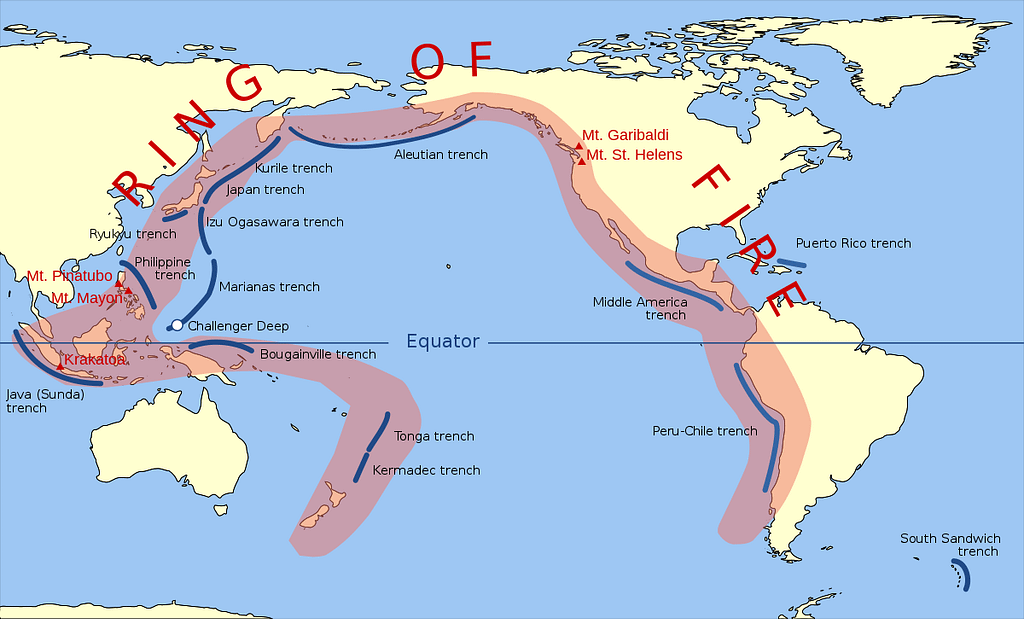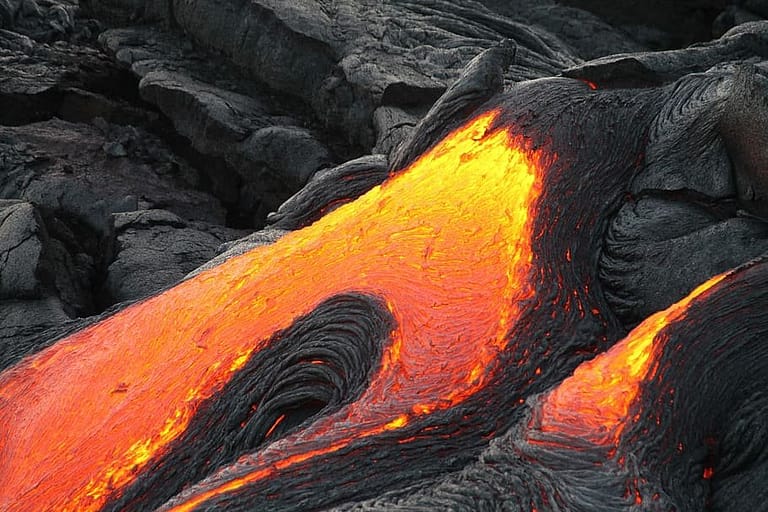Volcanoes, the Earth’s dynamic storytellers, captivate us with their fiery displays and shape our planet’s ever-changing landscapes. From the majestic mountains to the mysterious depths of the ocean, these geological wonders hold secrets of Earth’s inner workings.
In this exploration, we unravel ten remarkable facts about volcanoes, offering a glimpse into their diverse forms, explosive capabilities, and the vital role they play in shaping our world. Join us on a journey to discover the fascinating and sometimes perilous aspects of these natural marvels that have both inspired wonder and sparked caution throughout human history.

1. Ring of Fire Dominance: The “Ring of Fire” is a horseshoe-shaped zone encircling the Pacific Ocean and is home to approximately 75% of the world’s active and dormant volcanoes. This region is characterized by high tectonic activity, marked by the collision and subduction of several major tectonic plates. As these plates interact, magma is generated beneath the Earth’s crust, leading to the formation of volcanoes. Countries bordering the Pacific, such as Japan, Indonesia, Chile, and the western coasts of North and South America, experience heightened volcanic activity due to their proximity to the Ring of Fire. This zone is not only rich in volcanic phenomena but is also susceptible to earthquakes and tsunamis, showcasing the dynamic geological processes occurring along plate boundaries.
2. Underwater Volcanoes: While iconic volcanic eruptions often bring to mind towering mountains spewing lava and ash into the sky, a significant number of volcanoes lie hidden beneath the ocean’s surface. These underwater volcanoes play a crucial role in shaping the Earth’s geology, contributing to the formation of submarine mountain ranges known as mid-ocean ridges. These volcanic structures are often associated with tectonic plate boundaries, where magma rises to create new oceanic crust. Some underwater volcanoes can breach the ocean surface, forming islands or seamounts. The study of these submarine volcanic features provides insights into the Earth’s internal processes and the vast interconnectedness of its geological systems, emphasizing that volcanic activity is not confined to terrestrial landscapes but extends beneath the ocean, influencing the planet’s overall dynamics.

3. Supervolcanoes: Supervolcanoes are geological wonders capable of cataclysmic eruptions, dwarfing those of typical volcanoes. These colossal volcanic systems can expel an immense volume of magma and ash during an eruption, with consequences that extend far beyond the immediate vicinity. One notable example is the Yellowstone Caldera in the United States, which last experienced a supervolcanic eruption around 640,000 years ago. The sheer magnitude of these eruptions has the potential to alter global climate patterns, with the released ash and gases affecting the Earth’s atmosphere for an extended period. Despite their rare occurrence, supervolcanoes are closely monitored due to their catastrophic potential and the need to understand their behavior to mitigate potential risks.
4. Lava Composition: Volcanic eruptions exhibit a fascinating diversity in the composition of the lava they expel. One key factor influencing lava type is viscosity, or the resistance to flow. Aa lava, characterized by its rough and jagged texture, is associated with higher viscosity. In contrast, pahoehoe lava, known for its smooth and rope-like appearance, has lower viscosity. The type of lava produced is determined by the magma’s composition, which includes varying amounts of silica, minerals, and gases. Aa lava tends to result from more viscous, gas-rich magmas, while pahoehoe lava is associated with less viscous, fluid magmas. The flow patterns of these lavas can dramatically influence the landscape during an eruption, shaping the terrain and impacting the communities in their path. Understanding the different lava compositions not only contributes to the scientific understanding of volcanic processes but also aids in assessing the potential hazards posed by volcanic activity in specific regions.

5. Pyroclastic Flows: One of the most perilous and destructive phenomena associated with volcanic eruptions is the pyroclastic flow. This fast-moving, highly destructive mass of volcanic gas, ash, and rock fragments can race down the flanks of a volcano at astonishing speeds, reaching velocities of over 700 kilometers per hour (450 miles per hour). Pyroclastic flows are typically generated during explosive eruptions, where magma fragmentation produces a mixture of fine ash and larger volcanic rock particles. These flows are extremely hot, with temperatures exceeding 1,000 degrees Celsius (1,832 degrees Fahrenheit), and their density allows them to travel downhill with tremendous force. Pyroclastic flows pose a severe threat to both life and property, as they can engulf entire valleys and communities within minutes. Understanding and predicting the behavior of these flows is crucial for implementing effective evacuation measures and mitigating the impact of volcanic eruptions on vulnerable areas.
6. Volcanic Lightning: Volcanic eruptions can give rise to a breathtaking yet mysterious phenomenon known as volcanic lightning. This captivating display occurs when the ash plume ejected during an eruption generates static electricity through a process called triboelectric charging. As ash particles collide and interact in the turbulent volcanic plume, they become charged, leading to the release of electrical discharges in the form of lightning. The resulting lightning bolts can illuminate the erupting volcano with spectacular flashes, creating a surreal and dramatic scene. While the exact mechanisms behind volcanic lightning are not fully understood, scientists believe that the combination of ash particles, ice crystals, and turbulent atmospheric conditions plays a crucial role in its formation. Observing volcanic lightning provides valuable insights into the dynamics of volcanic eruptions and aids researchers in studying the complex interactions between magma, gases, and atmospheric elements during these explosive events.
7. Volcanic Islands Formation: Volcanic islands are captivating features formed through the dynamic processes of volcanic activity. These islands emerge as a result of the accumulation of lava and other volcanic materials, typically occurring at convergent or divergent tectonic plate boundaries. One remarkable example is the Hawaiian Islands, a chain of volcanic islands in the central Pacific Ocean. These islands are situated atop a hotspot, where a mantle plume generates magma that rises through the Earth’s crust, creating new landmasses over time. As tectonic plates move over the hotspot, a series of islands is formed, each marking the location of previous volcanic activity. The unique geological history of volcanic islands contributes to their diverse landscapes and ecosystems. From the black sand beaches of Iceland to the lush greenery of Hawaii, these islands showcase the powerful creative forces of volcanic activity shaping the Earth’s surface.
8. Volcanic Gas Emissions: Volcanic eruptions release a variety of gases into the atmosphere, influencing both local environments and the global climate. Among the gases emitted are water vapor, carbon dioxide (CO2), sulfur dioxide (SO2), and hydrogen sulfide (H2S). While water vapor is a relatively harmless component, other gases can have significant environmental and health impacts. CO2 is a greenhouse gas that contributes to climate change when released in large quantities. SO2 can lead to the formation of acid rain, impacting water bodies and vegetation. Additionally, volcanic gases may have short-term cooling effects on the climate by reflecting sunlight back into space. Monitoring and studying volcanic gas emissions are crucial for understanding their effects on air quality, climate, and ecosystems. This research helps scientists assess the potential hazards associated with specific volcanic eruptions and develop strategies for mitigating their impact on both local and global scales. Improved understanding of volcanic gas emissions also aids in the early detection of potential eruptions, allowing for better preparedness and risk management in vulnerable regions.
9. Volcanic Hazards: Volcanic eruptions pose a myriad of hazards, ranging from immediate dangers to long-term impacts on the environment and communities. Lava flows, perhaps the most iconic volcanic hazard, can consume everything in their path, destroying infrastructure and altering landscapes. Ashfall is another significant threat, blanketing large areas and causing respiratory problems in humans and animals. Pyroclastic flows, as mentioned earlier, are deadly fast-moving currents of hot gas and debris that can devastate large areas within minutes. Volcanic gases, such as sulfur dioxide, can lead to air pollution, acid rain, and respiratory issues, affecting both local and global environments.
In addition to these primary hazards, volcanic eruptions can also trigger secondary hazards. For instance, the melting of snow and ice on a volcano during an eruption can lead to lahars – fast-flowing mudflows that can bury communities downstream. Volcanic earthquakes, often preceding or accompanying eruptions, can cause landslides and further contribute to the instability of volcanic slopes. The complex interplay of these hazards requires careful monitoring and risk assessment to ensure the safety of communities living in proximity to active volcanoes. Advances in technology and improved understanding of volcanic processes contribute to better prediction and preparedness efforts, ultimately reducing the potential impact of these hazards.
10. Volcanic Monitoring: Monitoring volcanic activity is a crucial aspect of modern geology, allowing scientists to track changes within a volcano and predict potential eruptions. Various tools and techniques are employed for this purpose, including seismometers, gas analyzers, satellite imagery, and ground deformation measurements. Seismometers detect ground vibrations caused by magma movement, providing early indications of increased volcanic activity. Gas analyzers measure the composition and quantity of gases emitted by a volcano, offering insights into its internal processes. Satellite imagery helps monitor changes in the landscape, such as ground deformation or the emergence of new vents. Ground-based measurements, like GPS and InSAR (Interferometric Synthetic Aperture Radar), provide precise data on ground movement, offering valuable information about magma migration and potential eruption sites.
Continuous monitoring allows scientists to assess the level of risk associated with a particular volcano and issue timely warnings to nearby communities. Early detection of volcanic unrest enables the implementation of evacuation plans and other preparedness measures, minimizing the impact on human lives and infrastructure. The advancements in volcanic monitoring technology contribute to a better understanding of volcanic behavior, facilitating ongoing research to improve eruption prediction models and enhance the overall understanding of volcanic processes.

